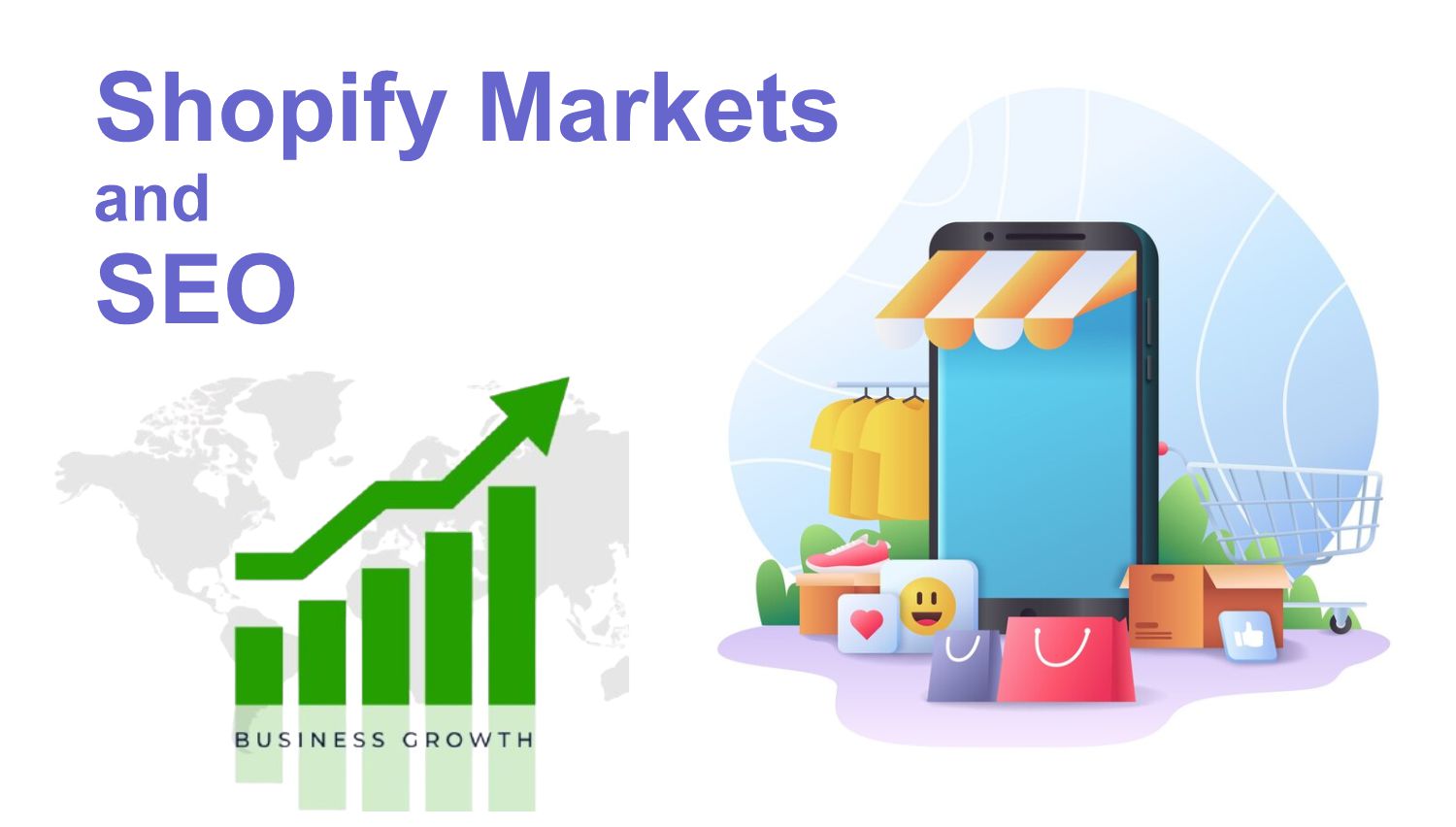If you’re using Shopify Markets—or considering it for your international expansion—you might be wondering:
“How does this affect my SEO?”
International SEO can be complex, and many Shopify store owners mistakenly assume Shopify Markets takes care of everything automatically. While Shopify Markets provides a solid foundation, there are crucial technical SEO elements that require your attention if you want to rank effectively in different countries and languages.
This guide will break down how Shopify Markets structures URLs, implements hreflang tags, handles translations, mitigates duplicate content risks, and optimizes for regional search visibility. We’ll also highlight where Shopify Markets excels and where you may need additional strategies to maximize your SEO performance.
Key SEO Takeaways for Shopify Markets

Before diving into specifics, here are five essential things to know:
- Shopify Markets provides a basic international SEO framework, including hreflang tags and subfolder URL structures, but it’s not a fully automated solution.
- Duplicate content issues can arise if you don’t properly localize product descriptions, meta titles, and other content for each region.
- Shopify does not auto-translate your content. You must use translation apps or manually input translations to improve rankings in different languages.
- Properly managing redirections is crucial to avoid issues like hiding content from Googlebot or creating indexing problems.
- Shopify Markets is a great starting point for global expansion, but businesses with complex localization needs may require additional SEO strategies or Shopify Plus features.
1. How Shopify Markets Structures URLs for SEO

When you activate Shopify Markets, your store automatically creates different URLs for each market using subfolders:
- yourstore.com → Default market (e.g., U.S.)
- yourstore.com/fr → French market
- yourstore.com/de → German market
- yourstore.com/en-ca → English version for Canada
For Shopify Plus users, additional URL structuring options are available, such as:
- Subdomains (e.g., fr.yourstore.com for the French market)
- Country-specific domains (e.g., yourstore.fr, yourstore.co.uk)
🔍 SEO Impact: Subfolders vs. Subdomains vs. Country Domains
Each URL structure has advantages and disadvantages:
✅ Subfolders (Recommended for Most Stores)
- Keeps all content under one root domain, consolidating domain authority.
- Easier to manage in Google Search Console and analytics tools.
- Shopify automatically applies hreflang tags to guide search engines.
⚠️ Subdomains & Country Domains
- Subdomains act as separate sites in Google’s eyes, requiring individual SEO efforts.
- Country domains are the best for deep localization but demand strong local backlinks and separate SEO strategies.
👉 Best practice: Use subfolders unless you need entirely separate SEO strategies per country.
2. Does Shopify Markets Handle Hreflang Tags Correctly?
Hreflang tags tell search engines which version of a page to display based on the user’s language or location. Shopify Markets automatically adds hreflang tags when you publish translated content.
Example Hreflang Setup:
<link rel="alternate" hreflang="en" href="https://yourstore.com/" />
<link rel="alternate" hreflang="fr" href="https://yourstore.com/fr" />
<link rel="alternate" hreflang="de" href="https://yourstore.com/de" />🔍 SEO Impact of Shopify’s Hreflang Implementation
✅ Pros:
- Automatically applies hreflang tags, reducing the risk of duplicate content penalties.
- Helps Google display the right language version to the right audience.
- No need for manual coding.
⚠️ Cons:
- If translations aren’t published or properly linked, hreflang tags won’t function correctly.
- No manual editing options unless you use a custom theme or Shopify Plus.
- Hreflang does not improve rankings—it only ensures the correct version is served.
👉 Best practice: Always ensure your translations are complete and properly interlinked.
You may like this also: Shopify POS (Point of Sale) Review
3. Managing Duplicate Content Risks in Shopify Markets
When Shopify Markets creates localized versions of your site, it often duplicates your content across different regions. If you don’t properly localize it, Google may treat these as duplicate pages and downrank them.
How Shopify Handles Duplicate Content:
- Shopify automatically adds canonical tags to localized versions, pointing back to the default version.
- This signals to search engines that different market pages are variations, not duplicates.
🔍 SEO Impact: Canonical Tags & Duplicate Content
✅ Pros:
- Prevents most duplicate content penalties.
- Helps search engines understand the relationship between language versions.
⚠️ Cons:
- Over-reliance on canonical tags without proper localization can harm rankings.
- Google may prioritize the default version instead of country-specific pages.
👉 Best practice: Always localize product descriptions, meta titles, and other key content to differentiate each market version.
4. Language & Translation SEO Challenges
Shopify Markets enables multilingual sites, but it doesn’t provide automatic translations. To rank well in different languages, you need to:
- Use Shopify Translate & Adapt (manual + AI-assisted) or third-party apps like Weglot, Langify, or ConveyThis.
- Manually translate meta titles, descriptions, and product descriptions—not just on-page text.
- Ensure translations sound natural and relevant to native speakers.
🔍 SEO Impact of Language & Translation
✅ Pros:
- Shopify supports full translation of product pages, blogs, menus, and metadata.
- Hreflang tags ensure search engines show the right language version.
⚠️ Cons:
- Poor translations (e.g., Google Translate) can hurt rankings and conversions.
- Some translation apps don’t support SEO fields unless configured properly.
- Browser-based language redirection may confuse Googlebot.
👉 Best practice: Treat translations as SEO assets—optimize them like any English-language page.
Geo-Redirection in Shopify Markets: Advantage or Pitfall?
Shopify Markets provides merchants with the ability to automatically redirect visitors based on their geographic location or browser language. With the latest update in January 2024, Shopify enhanced this feature to include both country/region-based redirection and language-based redirection. While this sounds like a seamless solution for improving the user experience, it carries potential SEO risks if not managed properly.
Key Features of Shopify Markets Geo-Redirection
Here’s how Shopify’s geo-redirection functions:
- If a user in France visits yourstore.com, Shopify can automatically redirect them to yourstore.com/fr to display the French version of the store.
- If a visitor’s browser language is set to German, Shopify can route them to yourstore.com/de, eliminating the need for manual selection.
- Merchants also have the option to add manual selectors, such as a language or country switcher, to provide users with control over their browsing preferences.
While this enhances the customer experience by personalizing content, there are important SEO implications to consider.
SEO Impact of Geo-Redirection in Shopify Markets
✅ Benefits:
- Delivers the correct language or regional content to users automatically, improving engagement.
- Boosts conversion rates by showing localized pricing, messages, and relevant payment options.
- Shopify’s system ensures that Googlebot is not redirected by default, reducing indexing issues.
⚠️ Potential SEO Challenges:
- Misconfigurations may prevent search engine crawlers from properly indexing international pages.
- Googlebot predominantly crawls from a U.S. IP address, so aggressive redirection could prevent global versions from being indexed.
- Not all users want automatic redirection—travelers or expatriates might prefer to browse their home-country version.
Best Practices for Geo-Redirection
To balance SEO performance with user experience, consider these strategies:
- Use Soft Redirection Prompts: Instead of forcing redirection, display a banner saying, “You’re browsing from Canada—Switch to the Canadian store?”
- Keep Manual Selectors Visible: Provide users with an option to choose their preferred store version.
- Ensure Googlebot Access: Avoid blocking crawlers from indexing international pages.
Tracking SEO Performance by Region or Language in Shopify Markets
One of the overlooked challenges of Shopify Markets is measuring SEO performance for different regions or languages. Since Shopify Markets relies on subfolders (e.g., /fr, /de, /en-ca) under a single domain, analytics data is consolidated by default. This makes overall reporting simple but limits the ability to analyze market-specific SEO insights.
How Shopify Markets Affects SEO Tracking
- All international pages reside under a single Google Search Console (GSC) property, making it harder to isolate regional performance.
- Google Analytics 4 (GA4) does not automatically segment traffic by market or subfolder without manual configuration.
- Language-specific SEO performance is not immediately visible without custom reporting.
SEO Benefits and Challenges of Consolidated Data
✅ Advantages:
- A single domain structure consolidates authority, boosting domain strength.
- Shopify’s built-in analytics and GA4 function seamlessly across all markets.
- UTM parameters and customized dashboards can be leveraged for detailed tracking.
⚠️ Drawbacks:
- Market-specific performance remains hidden unless segmented manually.
- Google Search Console does not break down clicks, impressions, or rankings per subfolder unless explicitly filtered.
- Shopify lacks a native tool to provide detailed SEO breakdowns by region.
How to Track SEO Performance Across Markets
- Set Up URL-Based Filters in GA4 and Looker Studio to monitor traffic by subfolder (e.g., /fr, /de).
- Use Search Console Page Filters to view queries and impressions for different language versions.
- Tag Regional Content with UTMs to track localized engagement across campaigns.
Without proper segmentation, merchants may miss valuable insights about regional SEO performance or fail to capitalize on high-potential markets.
You may like this also: 27 Essential Shopify Apps to Elevate Your Store
When Shopify Markets May Not Be Enough for SEO
While Shopify Markets provides essential tools for international SEO—including hreflang tags, subfolder structures, and browser-based redirection—it has limitations. Businesses with advanced SEO needs may require a more flexible approach.
When Should You Consider Separate Stores?
Merchants may outgrow Shopify Markets if:
- They require distinct country-specific domains (yourstore.co.uk, yourstore.jp) for stronger regional SEO signals.
- Their content strategy involves country-specific blogs, landing pages, or unique editorial calendars.
- Keyword targeting varies significantly across countries (i.e., simply translating content is not enough).
- Regional teams need independent control over SEO tools, integrations, and content management.
- They sell different product variants due to regional compliance or consumer preferences.
SEO Impact of Separate Stores vs. Shopify Markets
✅ Pros of Using Separate Stores:
- Country-specific domains improve regional SEO rankings.
- Greater control over content, keywords, and backlink profiles.
- Ideal for large-scale SEO campaigns with dedicated local teams.
⚠️ Cons of Managing Separate Stores:
- Requires more technical setup and ongoing coordination.
- Involves managing multiple analytics and search console accounts.
- Risk of brand inconsistency if strategies are not well-aligned.
Hybrid Approach: The Best of Both Worlds
Many global brands use a hybrid strategy:
- Shopify Markets for smaller or emerging regions where a single store is sufficient.
- Separate stores for high-priority markets that require customized SEO strategies.
You may like this also: Shopify vs Wix
Does Shopify Markets Help or Hurt SEO?
✅ Shopify Markets provides a solid starting point for international SEO, but it’s not a complete solution. ✅ Shopify’s automatic hreflang and canonical tag implementation reduces SEO complexity. ✅ Using subfolders is the best option for most stores, balancing simplicity and SEO effectiveness. ❌ However, Shopify does not automatically translate content, fix duplicate content risks, or handle advanced localization.
🚀 Pro Tip: If your international SEO strategy involves regional link-building, heavy localization, or different product offerings per country, consider upgrading to Shopify Plus with Expansion Stores for more flexibility.
Next Steps:
✔️ Set up Google Search Console for each market. ✔️ Manually translate and optimize key pages. ✔️ Regularly check for duplicate content issues. ✔️ Monitor international rankings and adjust as needed.
By following these steps, you can maximize your SEO performance on Shopify Markets and dominate international search results!
Conclusion: Shopify Markets for SEO—A Strong Start, But Not a One-Size-Fits-All Solution
Shopify Markets offers a robust foundation for international SEO by providing:
- Subfolder structures for clear URL organization.
- Auto-generated hreflang tags to indicate language and region.
- Browser-based redirection that respects search engine crawling.
- The ability to manage a multilingual store from a single Shopify admin.
However, success in global SEO goes beyond technical optimizations. True localization—not just translation—is key. Even the best hreflang implementation won’t compensate for showing an English product description to users in five different countries.
For brands with complex SEO needs, Shopify Markets is a stepping stone. If organic traffic is a key growth driver and regional markets differ significantly, transitioning to separate stores with country-specific domains may be necessary.
Final Advice: Shopify Markets is ideal for businesses expanding gradually. But if SEO is a core strategy and your international markets have distinct needs, be ready to scale beyond it when the time is right.
Frequently Asked Questions (FAQs)
Does Shopify Markets negatively impact SEO? No, Shopify Markets follows SEO best practices such as hreflang tags, canonicalization, and structured subfolder URLs. However, proper content localization is crucial to maintaining strong rankings.
What URL structure does Shopify Markets use? Shopify Markets uses subfolders (e.g., /fr, /de, /en-ca) to organize content under a single domain, consolidating SEO value.
Does Shopify automatically translate my store? No. Shopify provides translation tools like the Translate & Adapt app, but merchants must add translations manually, including SEO metadata.
Can geo-redirection impact SEO? Yes, if misconfigured. However, Shopify prevents redirection of Googlebot by default, reducing indexing risks. Using manual selectors and soft redirection prompts is recommended.
When should I consider moving beyond Shopify Markets? If your SEO strategy requires country-specific domains, unique content strategies, or regional backlinks, Shopify Markets may be too limited. In such cases, separate stores offer greater flexibility.

